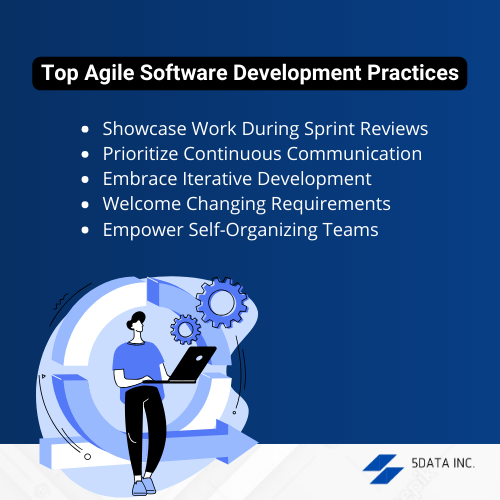In the world of software development, the journey to deliver value is always a priority. But how you navigate that journey can make all the difference. Traditional approaches, like the linear Waterfall method, offer little room for course correction.
It’s like setting out on a road trip without a map until you reach the end. Agile, on the other hand, is the GPS for application development. It’s an iterative approach that emphasizes delivering value faster and with more frequent check-ins.
Think of it as making pit stops along the way, ensuring you’re on the right path. Agile has become the default choice for software teams for a reason. It’s customer-centric, built for feedback, and adaptable to change.
Whether you are new to Agile or a seasoned pro, this article is your guide to delivering value fast and frequently, making it a must-read for businesses of all sizes.
What we cover in this blog
Agile Software Development
Agile Application development is a methodology that prioritizes adaptability and responsiveness, akin to a skilled craftsperson adeptly adjusting to different materials and tools. It empowers software development teams to work efficiently and swiftly adapt to changes. Let’s delve into its core principles:Iterative and Incremental Approach
The agile principle doesn’t tackle software development in one long, unbroken line. Instead, it breaks the work into shorter increments known as “sprints.” These sprints are like small, manageable phases, typically lasting one to four weeks. At the end of each sprint, the team evaluates their progress, gathers valuable feedback, and refines their approach for the next sprint.Flexibility and Customer Collaboration
The agile approach focuses on flexibility and collaboration with customers. It’s designed to accommodate changing requirements and priorities. It means that as a project evolves, Agile allows for adjustments and refinements without causing major disruptions. Customers and stakeholders are actively involved throughout the development process, ensuring that the end product aligns with their needs and expectations.Agile Manifesto and Its Values
Central to Agile is the Agile Manifesto, which comprises a collection of fundamental values and principles. This manifesto places a strong emphasis on prioritizing customer satisfaction by ensuring the early and continual delivery of valuable software. It also promotes the flexibility to embrace changing requirements, even in the later stages of development. Furthermore, Agile emphasizes the frequent delivery of functional software and close collaboration with both customers and development teams. These values highlight the significance of individuals and interactions, functional software, and customer collaboration, elevating them above the importance of processes and tools.Why Do Organizations Need Agile Methodologies?
Agile best practices enable organizations to stay responsive and competitive in an ever-changing business landscape. Here are five main reasons why you should start taking the agile frameworks seriously:Evolution of Software Development
The software development landscape is continually evolving, driven by expeditious technological advancements and time-to-time customer demands. In this ever-shifting environment, the ability to adapt quickly is paramount. Agile project management provides the agility required to thrive in this dynamic setting.Challenges of Traditional Development
Traditional methodology, such as the Waterfall model, have their limitations. They follow a linear approach with little room for course correction, which can cause projects that are slow to respond to changes, often leading to missed opportunities and increased development costs. Agile principles address these drawbacks by offering a more flexible and responsive approach.Swift Response to Changing Requirements
In today’s market, customer requirements and market dynamics can shift rapidly. Traditional project management approaches struggle to keep pace with these changes, which can lead to outdated or misaligned products. Agile’s iterative and incremental development ensures that the project development teams can quickly pivot to meet evolving customer needs, delivering value faster and reducing time-to-market.Enhanced Product Quality and Customer Satisfaction
Agile best practices focus on the continuous improvement of small, functional increments. These not only enable faster feedback from customers but also allow for immediate issue resolution and quality improvements on the working software. As a result, product quality is enhanced, and customers are more satisfied as they see their input promptly incorporated into the development process.Improved Team Collaboration
Agile projects promote collaboration among team members, breaking down silos that can hinder communication and productivity. Regular meetings, such as daily stand-ups and sprint reviews, foster open team communication and create a sense of shared ownership. This collaborative environment encourages innovation and problem-solving, resulting in more effective and cohesive agile team(s). Unlock the power of Agile best practices with your trusted partner for the best application development services.
Five Best Practices For Agile Software Development
Adopting the Agile approach is a journey that involves embracing a set of best practices to ensure sustainable development for complex projects. Here are five essential agile practices for successful projects: 1. Showcase Work During Sprint Reviews:- Distinct from sprint retrospectives, sprint reviews focus solely on showcasing the work accomplished during a sprint for better team performance.
- Conduct sprint reviews on the last day of the sprint, ahead of the retrospective.
- Highlight the deliverables created, gather feedback from stakeholders, update the product backlog, and prepare for the next sprint.
- Keep the review centered on the work itself; culture and system improvements are reserved for the retrospective.
- Foster efficient and effective interaction among development team members, stakeholders, and customers.
- Daily stand-up meetings, also known as daily scrums, are essential for keeping the other team members well-informed about progress and challenges, setting the stage for productive scrum team retrospective(s).
- Ensure that team members actively participate in discussions and provide regular updates on their tasks for better communication-coordination balance.
- Break down the project into small, manageable increments or sprints.
- Develop and deliver functionality in these short iterations using efficient tools and working software.
- Frequent feedback from stakeholders helps in adjusting requirements and priorities for subsequent sprints.
- This iterative approach supports early and continuous delivery and helps agile teams track progress and be on the same page.
- Embrace changes in customer requirements, even if they arise late in the agile process.
- Implementing agile processes allows the achievement of a lean development model, enabling the project teams to rapid application development.
- Prioritizing customer collaboration instead of contract negotiation. Embracing change response over rigidly following a fixed plan. These agile approaches represent value-based business priorities.
- Follow lean manufacturing principles for an efficient product development process.
- Encourage self-organizing teams to make decisions regarding how they work and accomplish tasks.
- Trust in the expertise and judgment of team members to determine the best approach, like maintaining one agile coach notes.
- This approach fosters innovation and problem-solving within the team for continuous integration and harnesses team productivity.
- Self-organizing teams are more likely to take ownership of their work and contribute to project success.
Conclusion
In short, agile processes harness change around customer-centricity. As we explored Agile’s core principles, best practices, and the significance of organizational agility, it’s essential to remember that adopting lean project management and test-driven development(s) makes agile methods sustainable. Our team at 5DataInc is here to guide you in this Agile journey, helping you choose the path that aligns perfectly with your unique business goals. Unlock the success of your software development projects with the best software application development company by your side, guiding you through seamless integration.
About the Author...
Almaas Saleem is a skilled software engineer from Kerala, India who currently resides in East Africa. She is passionate about technology and constantly seeks to learn more about it through reading and hands-on experience. Almaas excels in web development, design, automated testing software, ethical hacking, cybersecurity, and digital marketing. She also works as a technical writer for new businesses, managing various entities. Almaas is distinguished by her steadfastness and commitment to her work, which consistently yields excellent results.
